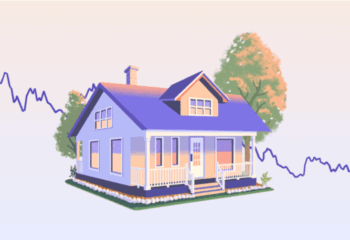If you’re a homeowner, your mortgage payments are probably one of your biggest expenses each month. And as you know, those payments are in large part determined by your mortgage interest rate. Because of this, changing your interest rate by refinancing your mortgage can be very beneficial—especially if your current rate is fairly high, which it might be if you purchased your home recently.
The decision to refinance might seem like a simple one—refinance as soon as you learn you can get a lower interest rate. But it’s a little more nuanced than that. In this post we’ll provide a primer on mortgage refinancing so you can confidently determine whether it’s the right fit for you.
Refinancing lets you lock in a lower interest rate
You’re probably familiar with the main benefit of refinancing: Getting a lower interest rate on your mortgage. Over time, this can help you save a lot of money on interest costs. Consider the simplified example below, which shows how much a lower interest rate can affect your monthly payment and total interest cost over 30 years.
| Original Mortgage | Refinancing |
| $500,000 principal remaining 7% interest rate, 30-year fixed rate | $500,000 principal remaining 6.5% interest rate, 30-year fixed rate |
| $3,326.51 monthly payment | $3,160.34 monthly payment |
| $697,543.60 total interest cost over the life of the loan | $637,722.40 total interest cost over the life of the loan |
As you can see, lowering your interest rate by even half of a percentage point can make a significant difference in what you owe each month. In the example above, you’d save about $60,000 in interest over the life of the loan just for refinancing. And in the same example, refinancing would shrink your monthly payments by over $150 per month. This could free up cash for a variety of other purposes—you could invest more, pre-pay your loan, or just enjoy the extra wiggle room in your budget.
You might have heard the rule of thumb that you should only refinance if you can get a rate that’s 1% or even 2% lower than your current rate. That isn’t necessarily right. This rule is somewhat old, and housing prices have increased significantly in recent years. Higher housing prices generally mean larger loans, and for larger loans, it takes a smaller change in interest rates to make refinancing worth it. Put another way, the bigger your loan is, the bigger the impact of a small interest rate change.
Beyond the interest rate: Closing costs and other considerations
As we mentioned above, interest rates aren’t the only consideration when you refinance. The situation is complicated by a few other factors, including the closing costs associated with taking out a new loan. These can include appraisal fees, title searches, deed-recording fees, and many others. These costs vary widely from lender to lender, and can be a source of confusion for many would-be refinancers.
When you refinance, closing costs can be around 2% of the amount you’re borrowing—so for the $500,000 loan in the example above, that would be $10,000. There is significant variation in that number, however—it could be higher or lower depending on a host of individual factors. One of the biggest factors that can drive closing costs up or down is how you handle property taxes and homeowner’s insurance. If you choose to impound taxes and/or insurance, taking out a new loan (refinancing) will require a new impound account and your lender will collect that money at closing.
You might get mail from financial institutions promising extremely low closing costs—or in some cases, no closing costs at all. We think it’s prudent to approach these offers carefully. Lenders with “low” closing costs often charge higher interest rates to make up the lost fees or add the closing costs to the mortgage balance, meaning these attractive-seeming loans can end up costing more in the long run. Rolling your closing costs into your new loan can make sense for some people, though—especially if you plan to invest the money you save up front and the gap between mortgage rates and expected investment returns is fairly wide.
Other factors that could influence your decision to refinance outside of interest rates are:
- Whether you are considering changing from an adjustable-rate mortgage to a fixed-rate mortgage, or vice versa
- Whether refinancing might allow you to stop paying private mortgage insurance (PMI)
- Whether you want to change the duration of your loan
- Whether you’re planning to take cash out when you refinance, potentially to pay off higher interest debt (this is most common in a low interest rate environment)
These factors depend a lot on the particulars of your specific situation, so we won’t get into them in detail here.
Refinancing: How to decide
A good way to decide whether or not to refinance your mortgage is by calculating your break-even point. Assuming you are refinancing with the goal of lowering your interest rate and thus your monthly payment, the question you need to answer is: How long will it take for my savings from a lower interest rate to exceed my closing costs?
For example, if you know your new interest rate will save you $200 a month and your closing costs will be $10,000, then it will take 50 months, or a little over four years, for you to hit your break-even point. If you think you’ll be in your home at least that long, then refinancing could make sense. But if you’re planning to sell your home in a year or two, that calculation tells you that refinancing probably isn’t the right move because you won’t benefit from the lower payments long enough to recoup what you spent on closing costs.
There are also some online calculators you can use to help you run the numbers, like this one from Freddie Mac.
Final thoughts on refinancing
If you think you could benefit from refinancing, then there are a few practical steps you can take to get ready. You can work on your credit score, keep your debt-to-income (DTI) ratio low, and build up some extra savings in a high-yield account like the Wealthfront Cash Account (which offers an industry-leading 3.50% APY from our program banks) to help cover your closing costs if you decide not to roll them into the new loan. That way, you’ll be ready when an attractive opportunity to refinance presents itself.
Disclosure
The information contained in this communication is provided for general informational purposes only, and should not be construed as investment, tax, or home lending advice. Any links provided to other server sites are offered as a matter of convenience and are not intended to imply that Wealthfront Corporation or its affiliates endorses, sponsors, promotes and/or is affiliated with the owners of or participants in those sites, or endorses any information contained on those sites, unless expressly stated otherwise.
The Cash Account is offered by Wealthfront Brokerage LLC (“Wealthfront Brokerage”), Member of FINRA/SIPC. Wealthfront Brokerage is not a bank, and the Cash Account is not a deposit account. The Annual Percentage Yield (“APY”) on cash deposits as of June 1, 2025, is representative, requires no minimums, and may change at any time. The APY for the Wealthfront Cash Account represents the weighted average of the APY on the aggregate deposit balances of all clients at insured depository institutions that participate in our cash sweep program (the “Program Banks”). Wealthfront sweeps available cash balances to Program Banks where they earn the variable APY.
About the author(s)
Michael Young is a Director of Product at Wealthfront. He studied Economics at Stanford University. View all posts by Michael Young



